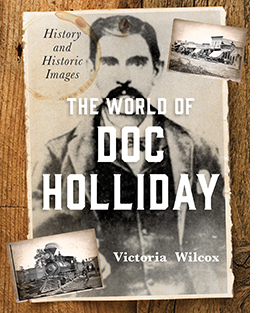|
This book began with a ride on the historic Durango & Silverton Narrow Gauge Railroad, the famous scenic train route through the San Juan Mountains of Southwestern Colorado. I was on a book tour and headed to the old mining camp of Silverton, high in those mountains, to give a talk about John Henry “Doc” Holliday, who had spent some time gambling there according to a report in an 1885 newspaper. The route was beautiful, the narrow rails clinging to the cliff walls with spectacular views of the Animas River far below—a sight that Doc Holliday had surely also enjoyed on his way to Silverton. And somewhere along the way, I realized that no historian had yet written about Doc’s travel routes—and that most of those travels went by rail, as for most of his life he went where the railroads went or where they were coming and bringing business. He was not a frontiersman, living off the land. He was not a Southern planter living off the labor of slaves who worked the land, although that had been his legacy. He was a modern Victorian man, well-educated and well-trained for a professional career, a man whose life seemed destined to be lived in the cities of nineteenth century America, cities connected by thousands of miles of rail. If his circumstances hadn’t taken a surprising change, sending him West into legend as Doc Holliday, he would likely never have taken part in a posse ride across a Western desert, or taken a stage coach ride across a precipitous Rocky Mountain pass. But even in the West, most of his journeys were made by rail and most of his sightseeing was done from the windows of a railcar. By the time I got back home to Georgia, this book was already coming together in my mind. It would be a different kind of Doc Holliday history: a travelogue of his adventures filled with images and anecdotes about the people and places that filled his world. And as the era of rails was also an era of newspapers, much of the story would come from contemporary newspaper accounts and interviews with Doc himself and the people who knew him, a first-hand account of his life. As the book was inspired by a train ride, the chapter titles would be inspired by the names of the railroads Doc traveled—from Georgia to Texas, from Dodge City to Las Vegas, across Arizona and from New Mexico to Colorado and Montana. For Tombstone, after all, was only a short eighteen months of his adventurous life, and there was so much more to Doc Holliday than a gunfight near the O.K. Corral. From TwoDot Books/Globe Pequot (December 18, 2020) Hardcover, 304 pages |
- Home
- About
- Books
- Doc Holliday Stories
- An Evening with Doc Holliday
- Leadville Takes a Shot
- Designing Doc Holliday
- Why Doc Holliday Killed Johnny Ringo in “Tombstone”
- Why Doc Holliday Went West
- Doc Holliday: Before the Legend
- The Mysterious Dr. Holliday of Dodge
- Doc Holliday’s Family Affair
- Doc Holliday & Dr. Long: Bringing Life to a Legend
- Doc Holliday and the Ghost of Ed Bailey
- Graves in the Garden – Doc Holliday’s Family & The Civil War
- Fire and Ice: Doc Holliday in Philadelphia
- The Face Behind The Fireplace
- I’m Your Huckleberry
- Bringing Doc Holliday Home
- Tucson, Trainyards, and Festival Tents
- Haunted by History
- Doc’s Last Cold Days
- Doc Holliday’s Florida Getaway
- Searching for Doc’s Grave
- St. Louis and the Southern Son
- An Irish Blessing
- Doc’s Holliday in New Orleans
- Roads To Tara
- Haunting the Holliday House
- Sunset for a Southern Lady
- Dancing with Doc Holliday and Rhett Butler
- On Writing
- Events
- Contact
Copyright 2025 Victoria Wilcox Books
Website Designed and Maintained by Mindwhirl


